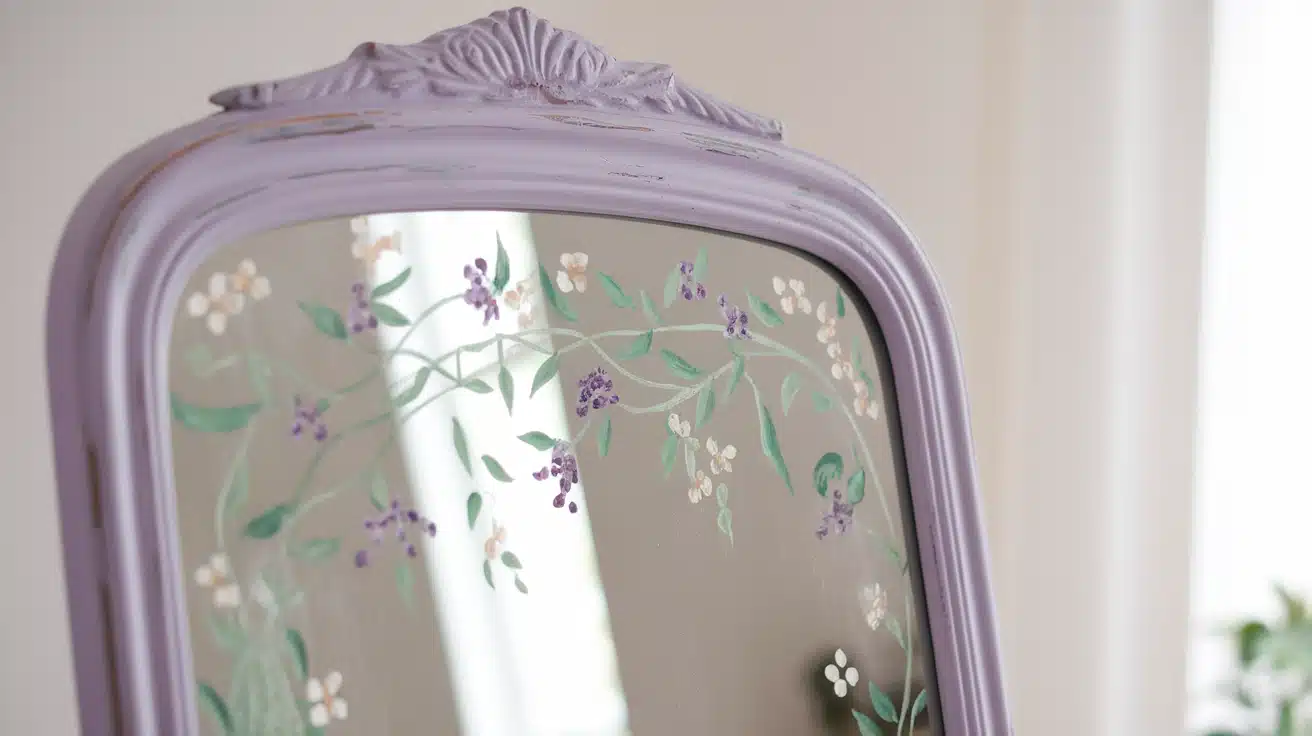Tired of plain mirrors that don’t match your home style? Many people think mirrors can’t be painted, They’re wrong.
Painting mirrors isn’t just possible—it’s simple when you know the right steps. With basic tools and a few hours, you can turn an ordinary mirror into something unique and personal.
This guide shows you exactly how to paint mirrors without mistakes. You’ll learn which paints work best, how to prepare your surface properly, and techniques that ensure lasting results.
Plus, we’ve included 5 fresh ideas to spark your creativity. From frame updates to glass designs, these projects work for all skill levels.
Ready to start? Let’s make your mirrors stand out.
Why Painting Mirrors Suddenly Became a Trend?
Mirror painting has gained huge popularity online for good reasons. Social media platforms like Instagram, TikTok, and Pinterest now show thousands of posts with people sharing their mirror art projects.
This trend has caught on because it offers a way to make personal items at home. Many folks want unique home items without buying new things, and painting mirrors lets them change what they already own.
Visual appeal plays a big role, too. Painted mirrors create striking effects when light hits them. They catch the eye in photos and videos, making them perfect for social media content.
DIY culture has grown during recent years. People enjoy making things with their hands. Mirror painting fits this desire perfectly – it needs few tools, costs little money, and gives quick results.
The trend also fits with current home styles that value personal touches over mass-made items. A painted mirror shows the owner’s taste better than store-bought decor.
How to Paint a Mirror: Step-by-Step Process
Follow this simple guide to convert your plain mirror into a stunning piece of art with just a few basic tools and techniques.
Step 1: Gather Your Supplies
Before you start, collect all needed items in one place. You’ll need a mirror, chalk paint for the frame, multi-surface acrylic paints for glass, various brushes (including a 3/4 inch brush), cleaning supplies, and wax for finishing.
Make sure your work area has good lighting and protection for surfaces. Having everything ready makes the process smoother and prevents stops for missing tools.
Materials and Tools You’ll Need
| Materials/Tools | Description |
|---|---|
| Paints (chalk paint, spray paint, acrylic) | Choose paint that suits your style and surface type. Chalk paint is popular for a matte finish, spray paint for even coverage, and acrylic for versatility. |
| Brushes, rollers, painter’s tape | Various brush sizes for detailed work, rollers for larger surfaces, and painter’s tape to protect the glass. |
| Sandpaper, primer | Use fine-grit sandpaper for smoothing the frame and a good primer to ensure paint adheres properly. |
| Cleaning supplies (glass cleaner, cloth) | Essential for cleaning the mirror and removing any dirt or dust from the surface before starting. |
Step 2: Clean and Prepare the Mirror
Wipe the mirror with glass cleaner and let it dry fully. Remove any dust, oils, or marks which might stop paint from sticking well. If your mirror has an old frame, sand it lightly to help new paint stick.
Use painter’s tape to cover mirror parts you don’t want painted. Good prep work helps ensure your final piece looks clean and lasts longer.
Step 3: Paint the Mirror Frame
Apply chalk paint to the frame using even strokes. For better results, work in thin layers rather than one thick coat. Let each layer dry before adding more.
Apply paint thinly in some spots for a worn look. For full coverage, use two or three coats. The frame color sets the tone for your whole project, so choose carefully.
Step 4: Begin Mirror Surface Painting
Load your brush with multi-surface acrylic paint. Start with basic shapes or outlines of your design. Work from the outer edges toward the center to avoid smudging. For vine designs, use flowing strokes that curve naturally.
Keep your hand steady and don’t rush. Remember that less is often more – you can always add but it’s harder to remove excess paint.
Step 5: Add Details and Depth
Once your base design is dry, add smaller details with a finer brush. Create leaves by pressing your brush flat, then lifting as you pull away.
Mix lighter and darker shades of your colors to create depth. Add tiny dots, lines, or shapes to fill empty spaces. Step back often to check your work from a distance for balance.
Step 6: Apply Finishing Touches
Let all the paint dry completely, which may take several hours. Check for any spots you missed or areas that need more paint. Clean any smudges on the mirror with a cotton swab dipped in alcohol.
If desired, apply wax to the frame for protection and a slight sheen. Place your finished mirror in a spot with good light to show off your work.
Common Mistakes to Avoid While Painting a Mirror
Even the most careful painters can make errors. Avoid these common pitfalls to ensure your mirror project turns out perfectly the first time.
- Skipping preparation steps: Always clean and sand surfaces properly before painting to ensure good adhesion.
- Choosing the wrong paint type: Use chalk paint for frames and multi-surface acrylics for glass – other paints may peel off.
- Not allowing sufficient drying time: Rush between coats, and you’ll smudge your work. Follow drying times on paint labels.
- Overlooking sealing the frame: Without proper sealing, your beautiful frame paint job may chip or wear quickly.
- Poor taping leading to messy edges: Take time to apply tape firmly and evenly for clean lines between paint and mirror.
- Using too much paint at once: Thin layers build up better than thick ones, which can drip and look uneven.
5 Creative Mirror Painting Ideas to Try
Here are 5 easy mirror painting ideas you can refer to:
1. Sunflower Painting on Mirror
Bright yellow sunflowers with brown centers make any space feel sunny and welcoming. Paint them around the frame or let them spread onto the glass corners.
The bold colors stand out against any wall color. This design works well in living rooms, hallways, or bedrooms where you want to add a happy, natural feeling. Even beginners can create this with simple round shapes.
2. Strawberry Vine Design
Red strawberries with green tops connected by winding vines create a fresh, sweet look. The contrast of red fruit against green leaves stands out beautifully on mirror surfaces.
This design fits well in kitchen spaces, breakfast nooks, or children’s rooms. Paint the vines thinly and add small white flowers between the berries for extra charm. The pattern can be as full or as minimal as you prefer.
3. Geometric Patterns
Clean lines and shapes bring a modern style to any mirror. Try triangles, hexagons, or simple stripes in bold colors like black, gold, or navy blue. Space the patterns evenly for a planned look or cluster them for more visual interest.
This style suits offices, modern living rooms, or minimalist spaces. If you’re worried about steady hands, use a ruler and tape for straight lines.
4. Tropical Palm Leaves
Wide, fanned palm leaves in various green shades create a vacation feeling year-round. Paint them coming in from the edges or clustering in corners of your mirror.
The large shapes are easy to paint even for beginners. This style fits perfectly in bathrooms, bedrooms, or any room needing a touch of nature. Add tiny dots of light color for texture on the leaves.
5. Ocean Waves Design
Flowing lines in blues and white mimic gentle ocean waves on your mirror. Use different blue shades from navy to light aqua for depth.
This calming pattern works wonderfully in bathrooms, bedrooms, or any space meant for relaxation. The free-form nature of waves makes this design forgiving for new painters. Add tiny white dots to represent sea foam or splashes.
Pro Tips & Key Considerations
Here are five quick tips to help your mirror painting project succeed:
- Use quality brushes: Invest in a few sizes – thin for details, wider for backgrounds. Synthetic brushes work best with acrylics on glass.
- Test colors first: Try paints on a hidden spot before painting the whole design. Colors often look different when dry.
- Check lighting: Notice how light hits your mirror at different times of day. This affects how your design will look once complete.
- Sketch first: Draw your design on paper before painting to plan layout and spot any issues early.
- Add protection: Once your work is fully dry, apply a clear glass sealant to prevent scratches and make cleaning easier.
Conclusion
With the steps and ideas we’ve shared, you now have all you need to turn plain mirrors into personal art pieces.
Remember that painting mirrors is mainly about patience and careful work rather than perfect skill. Start with simpler designs before trying complex ones.
The beauty of mirror painting lies in making something truly yours. No two hand-painted mirrors will ever look exactly alike, and each brush stroke adds character to your home decor.
The next time you see a tired-looking mirror, think twice before replacing it. Your paints and brushes might be all you need to make it fresh and fitting for your space again.
Frequently Asked Questions (FAQs)
1. What Kind of Paint will stick to a Mirror?
Multi-surface acrylic paints stick best to mirrors, and chalk paint works well for frames. Always clean the glass first for proper adhesion, and consider a clear sealant afterward.
2. What Kind of Paint Do You Use to Make a Mirror?
Use multi-surface acrylic paints for glass surfaces. Chalk paint works best for mirror frames. Both types adhere well and offer good coverage for mirror painting projects.
3. Will Acrylic Paint Wash Off a Mirror?
Acrylic paint will wash off mirrors if applied without proper preparation. Use multi-surface acrylics and clean the glass thoroughly first. Then, apply a clear sealant for permanence.



















